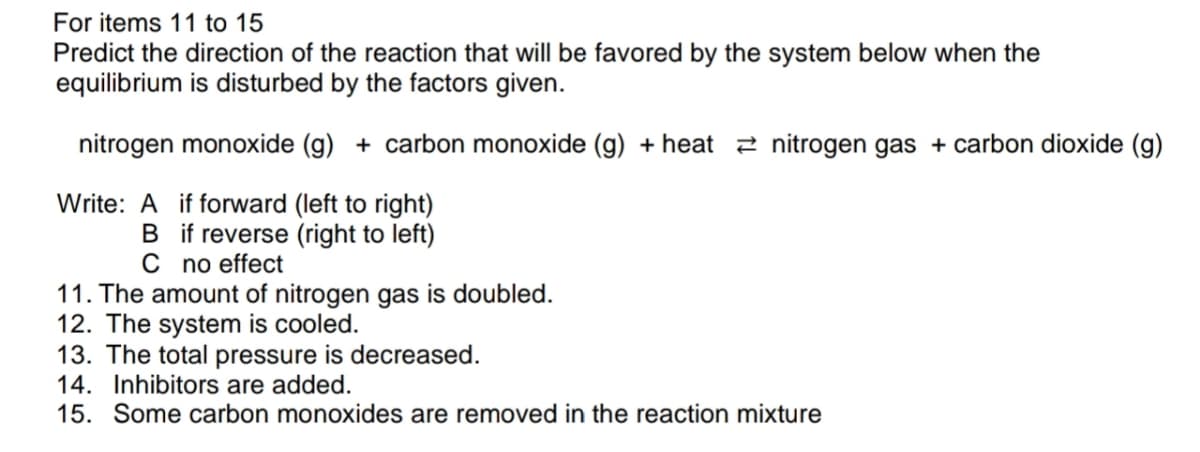For items 11 to 15 Predict the direction of the reaction that will be favored by the system below when the equilibrium is disturbed by the factors given. nitrogen monoxide (g) + carbon monoxide (g) + heat 2 nitrogen gas + carbon dioxide (g) Write: A if forward (left to right) B if reverse (right to left) C no effect 11. The amount of nitrogen gas is doubled. 12. The system is cooled. 13. The total pressure is decreased. 14. Inhibitors are added. 15. Some carbon monoxides are removed in the reaction mixture
For items 11 to 15 Predict the direction of the reaction that will be favored by the system below when the equilibrium is disturbed by the factors given. nitrogen monoxide (g) + carbon monoxide (g) + heat 2 nitrogen gas + carbon dioxide (g) Write: A if forward (left to right) B if reverse (right to left) C no effect 11. The amount of nitrogen gas is doubled. 12. The system is cooled. 13. The total pressure is decreased. 14. Inhibitors are added. 15. Some carbon monoxides are removed in the reaction mixture
Chemistry: Principles and Reactions
8th Edition
ISBN:9781305079373
Author:William L. Masterton, Cecile N. Hurley
Publisher:William L. Masterton, Cecile N. Hurley
Chapter12: Gaseous Chemical Equilibrium
Section: Chapter Questions
Problem 38QAP: Nitrogen dioxide can decompose to nitrogen oxide and oxygen. 2NO2(g)2NO(g)+O2(g) K is 0.87 at a...
Related questions
Question

Transcribed Image Text:For items 11 to 15
Predict the direction of the reaction that will be favored by the system below when the
equilibrium is disturbed by the factors given.
nitrogen monoxide (g) + carbon monoxide (g) + heat 2 nitrogen gas + carbon dioxide (g)
Write: A if forward (left to right)
B if reverse (right to left)
C no effect
11. The amount of nitrogen gas is doubled.
12. The system is cooled.
13. The total pressure is decreased.
14. Inhibitors are added.
15. Some carbon monoxides are removed in the reaction mixture
Expert Solution
This question has been solved!
Explore an expertly crafted, step-by-step solution for a thorough understanding of key concepts.
Step by step
Solved in 2 steps

Knowledge Booster
Learn more about
Need a deep-dive on the concept behind this application? Look no further. Learn more about this topic, chemistry and related others by exploring similar questions and additional content below.Recommended textbooks for you

Chemistry: Principles and Reactions
Chemistry
ISBN:
9781305079373
Author:
William L. Masterton, Cecile N. Hurley
Publisher:
Cengage Learning

Chemistry: The Molecular Science
Chemistry
ISBN:
9781285199047
Author:
John W. Moore, Conrad L. Stanitski
Publisher:
Cengage Learning

General, Organic, and Biological Chemistry
Chemistry
ISBN:
9781285853918
Author:
H. Stephen Stoker
Publisher:
Cengage Learning

Chemistry: Principles and Reactions
Chemistry
ISBN:
9781305079373
Author:
William L. Masterton, Cecile N. Hurley
Publisher:
Cengage Learning

Chemistry: The Molecular Science
Chemistry
ISBN:
9781285199047
Author:
John W. Moore, Conrad L. Stanitski
Publisher:
Cengage Learning

General, Organic, and Biological Chemistry
Chemistry
ISBN:
9781285853918
Author:
H. Stephen Stoker
Publisher:
Cengage Learning

Chemistry
Chemistry
ISBN:
9781305957404
Author:
Steven S. Zumdahl, Susan A. Zumdahl, Donald J. DeCoste
Publisher:
Cengage Learning

Chemistry: An Atoms First Approach
Chemistry
ISBN:
9781305079243
Author:
Steven S. Zumdahl, Susan A. Zumdahl
Publisher:
Cengage Learning
